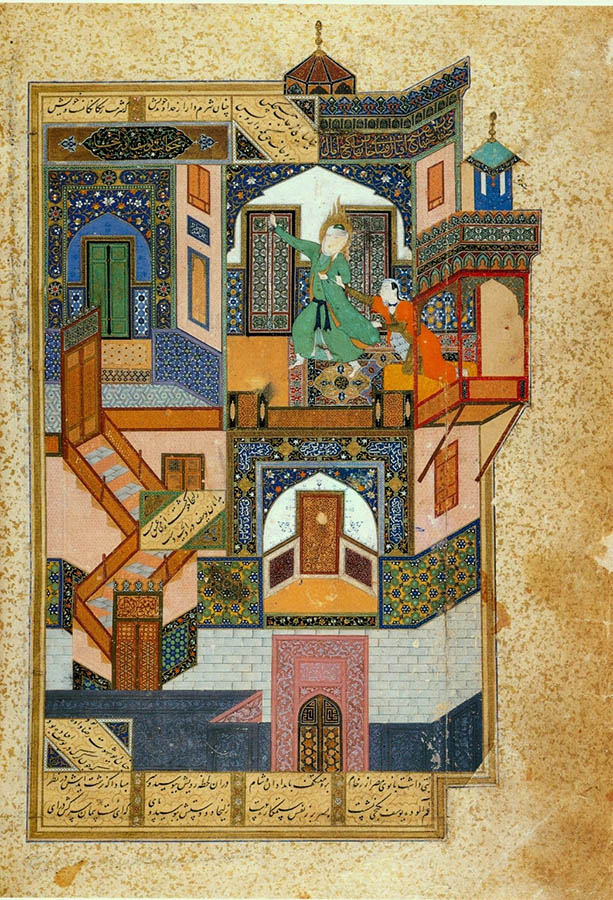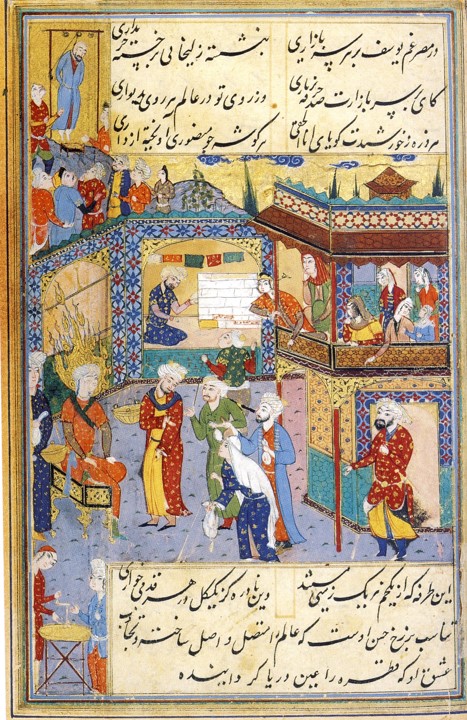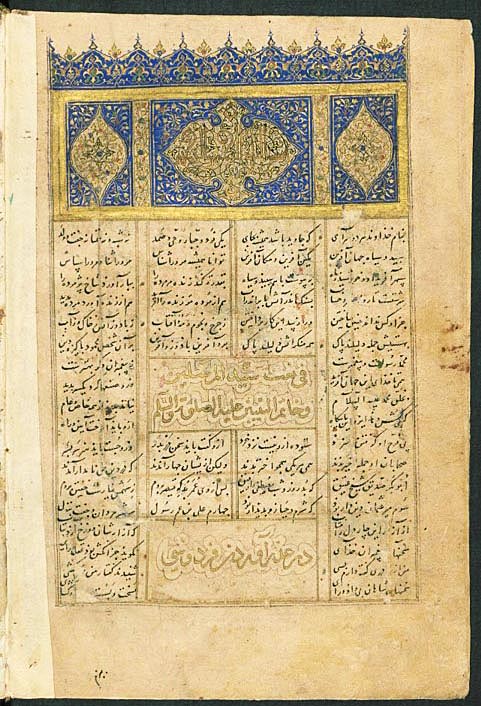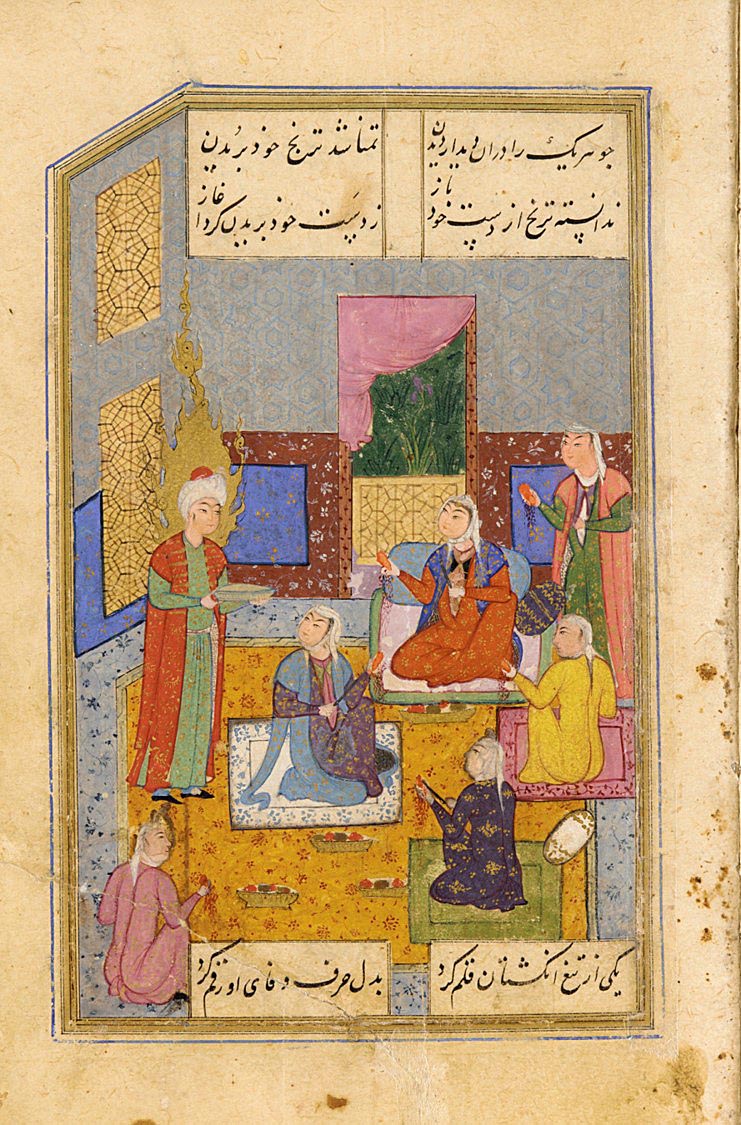The Story of Joseph
The story of Joseph, in the Islamic tradition known as Yusuf, is widely known both from the Bible and the Qur’an. It found great popularity in the Turko-Persian world between 1000 and 1500, when it started to appear in a growing variety of genres. This culminated in the 15th century, when the poet ʿAbd al-Rahman Jami composed his famous version of the narrative in the Timurid capital Herat. Earlier in the 15th century, the story became connected to one of the great names of Persian poetry: Abu’l-Qasim Firdausi, the poet who composed the Shahnama or Book of Kings, around the year 1000. The glorious pre-Islamic past as presented in the Shahnama was embraced in many ways by the Turkic and Mongol rulers who reigned over much of the Islamic world since the year 1000, and so was the moving and pious narrative of Joseph. How and why were the two brought together? This article explores the story of Joseph and its role in the cultural production of the Turko-Persian world, and discusses the connections between the story of Joseph, Firdausi, and the court culture of the Timurids.
Introduction: the emergence of Yusuf and Zulaykha
The story of Joseph features prominently in the Qur’an and its core elements therefore form part of the collective memory of many audiences in the medieval Muslim world. These audiences would be familiar with the Qur’anic narrative on Joseph, as related in Sura 12, which runs as follows:
The young Joseph tells his father Jacob about a dream, in which he saw eleven stars, the sun, and the moon prostrating before him. Jacob advises him not to tell these dreams to his brothers, in order not to provoke them. They, however, already resent the way their father seems to single out Joseph above all. The jealous brothers decide to lure him away from Jacob. On the road, they leave Joseph in a well, where he is found by caravan merchants and sold into slavery. He ends up in the household of a rich Egyptian. The wife of this Egyptian falls in love with him and tries to seduce him. When this is exposed, Joseph is falsely accused of seducing her; and even though he is proven innocent, he ends up in prison. There, his visionary dreams prove to be a blessing: they bring him freedom and a high position at the court of the Pharaoh, where he is ultimately reunited with his long-lost father and his brothers.
On the basis of this storyline, a wide variety of narratives started to circulate, many of which assigned a much greater role to the wife of the Egyptian merchant. She has no name in the Bible or the Qur’an; she is referred to in the Bible only as ‘the wife of Potiphar.’ In the many stories based on the Qur’anic tradition, her name is ‘Zulaykha’ or ‘Zalikha.’ Yusuf (Joseph) and Zulaykha became a proverbial couple, immortalized by numerous poets and writers, in a variety of genres, in Persian and other literary traditions. They became, for example, part of the rich imagery of lyrical Persian poetry, and poets such as Jalal al-Din Rumi (1207-1273) and Hafiz (c. 1315-1390) frequently refer to the figures of Yusuf and Zulaykha as symbols of devotion, separation, and forbearance, knowing that their audiences were familiar with the story and could understand these often passing references.
For most poets and authors writing in Persian, not only the 12th Sura in the Qur’an devoted to Yusuf was a source of inspiration, but especially also the works that were inspired by Qur’anic narratives: notably the various versions of Qisas al-anbiya, or ‘stories of the prophets.’ There are a number of compositions with this title in Persian, such as the Qisas al-anbiya by the 11th-century author Naysaburi, transmitted via a considerable number of illustrated manuscripts. 1 There is also a version in Middle Turkic, completed in 1310 by Rabghuzi, which is important also for the study of the development of Turkic languages in Central Asia. 2
In these works, storylines briefly presented in the Qur’an were taken up and built into more elaborate and longer narratives, which in turn served to inspire other authors. Elements of these narratives appear in a variety of literary genres in Persian – in lyrical poetry, but also in biographies of Sufi saints and in different types of verse romances.
The most well-known verse romance on Joseph in Persian is from the hand of the poet and Naqshbandi Sufi ʿAbd al-Rahman Jami (1414-1492). It is a long narrative poem (mathnawi) of 4032 double verses, completed in 1483 and entitled Yusuf-u Zulaykha. It is one of the many works of Jami, whose patrons were the Timurid rulers in Herat, in particular the Timurid Sultan Husayn Bayqara (r. 1469-1506). In the courtly circles of Sultan Husayn Bayqara, Jami’s fellow-poet, close friend, and disciple Nava’i (1441-1501) also played a considerable role. While Jami composed his mathnawi in Persian, Nava’i wrote mostly in Central Asian Turkish, usually referred to as Chaghatai at the time. Both languages played an important role at the Timurid court in Herat. Jami and Nava’i became patrons of literature, art, and architecture in their own right, and it is in this context that at the end of the 15th century cultural production in Herat thrived. The courtly elite commissioned richly illustrated manuscripts, many of which have been preserved and are now kept in libraries and museums all over the world.
The reception of Saʿdi’s Bustan at the Timurid court in Herat
One of the manuscripts produced at the court in Herat contains an iconic painting of the story of Yusuf and Zulaykha, made by one of the most famous painters in the history of Persian art, Kamal al-Din Behzad. This manuscript, dated 1488 and now kept in the Dar al-kutub in Cairo, is a copy of Saʿdi’s Bustan (‘Orchard’). The poet Saʿdi had composed this work two centuries earlier, in the second half of the 13th century, in his hometown Shiraz, a city which would become part of the Timurid Empire in the 14th century. The Bustan is a treatise in verse on morals and ethics, with many mystical overtones.
The painting that forms part of the 1488 manuscript copy of the Bustan depicts Zulaykha, trying to seduce Yusuf in a beautiful palace, where she chases him from room to room [Fig. 1]. It has often been noted that this palace, so central to this painting, does not occur in the text of Saʿdi’s Bustan. What Behzad’s painting illustrates is a passage of only nine verses: it is no more than a short anecdote in the context of the Bustan. 3 Its text focuses on Zulaykha’s lack of shame and false piety, and on Yusuf’s exemplary modesty, self-restraint, and true dedication to God. The passage serves as one of the many anecdotes to expand on and to illustrate the concepts of shame and remorse, the topic of the ninth chapter of the Bustan.

The palace and its features, so prominently present on Behzad’s painting in the Bustan manuscript, though not in the actual text of the work itself, also play a great role in Jami’s Yusuf and Zulaykha. Jami completed this work in 1483, only a few years before Behzad painted the scene of Zulaykha seducing Joseph for the Bustan manuscript. There is no doubt that Behzad was aware of the contents of Jami’s story and chose to make use of the strong visual elements he brought into the story. 4 The work of Jami would become a source of inspiration for many painters, and many illustrated manuscripts of Jami’s Yusuf and Zulaykha exist.
Jami’s Yusuf-u Zulaykha: the Sufi context
Jami framed the story of Yusuf and Zulaykha as a Sufi narrative, in which Zulaykha, presented as a shameless and evil figure in many sources, is at the end redeemed and purified. This is not surprising: not only was Jami a Sufi himself, but also by this time Sufism had permeated society, art, and literature.
An example of the Sufi appropriation of the story is visible in a biography of Sufi saints written at the beginning of the 16th century by a successful disciple of Jami, Kamal al-Din Gazurgahi, who dedicated this biography (Majalis al-ʿushshaq, ‘Assemblies of Lovers’) to Sultan Husayn Bayqara. By the time Gazurgahi wrote this work, the story of Joseph was very popular and well known, also as part of a Sufi framework. The allusions in the passage on Yusuf and Zulaykha, obscure to the uninitiated reader, were no doubt very clear for the audience then. The following passage shows how Yusuf and Zulaykha had by this time risen above individuality. They themselves as well as their stories symbolize the obstacles and thorns of the Sufi path: “In the Egypt of Joseph’s grief we find a Zulaykha, a high-ranked buyer, seated at every market’s upper end […] / Every atom of your sun speaks of ‘I am the Truth’ / Every corner is like a Mansur hanging from the gallows.” 5
The Egypt of Joseph’s grief stands for the predicament of every Sufi, who is likened to Zulaykha. To reach the Sufi ideal of the annihilation of the self, it is necessary to face combat with the lower soul, of which Zulaykha is a symbol – and she therefore needs to go through poverty and longing, in order to reach this ultimate goal. This is also hinted at in a painting in one of the many 16th century manuscripts of Majalis al-ʿushshaq [Fig. 2]. 6 The centre of this painting depicts Yusuf being sold on a slave market. Here the rich merchant’s wife Zulaykha sees Yusuf for the first time from her balcony, as she eagerly watches the proceedings. However, in a corner of the painting, we see in the distance a man hanging from the gallows, and this utter sacrifice, albeit in a different manner, is also what awaits Zulaykha. In Majalis al-ʿushshaq, Gazurgahi does not go into the story of Yusuf and Zulaykha any further. Just like Saʿdi and many other authors, Gazurgahi selected the element from the story that suited the goal of his work, knowing that his audience would grasp its meaning and context.

Fig. 2: Yusuf offered for sale, Zulaykha watches from her balcony. Painting from a manuscript of Shaykh Kamal al-Din Husayn Gazurgahi’s Majalis al-‘ushshaq (‘Assemblies of lovers,’ 1503-4), Ms. I. 1986, Berlin, Museum für Islamische Kunst, fol. 5r. Late 16th century. From Almut von Gladiss, Die Freunde Gottes. Die Bilderwelt einer persischen Luxushandschrift des 16. Jahrhunderts. Berlin: Museum für Islamische Kunst, Staatliche Museen zu Berlin, 2005, 8.
If we track the story’s proliferation onwards, as it appears in Jami’s Yusuf-u Zulaykha and likewise in Naysaburi’s Qisas al-anbiya, we learn that Zulaykha becomes the laughing stock of a number of ladies in the city. This occurs once Yusuf is a slave in her household, because of her incurable passion for him. To restore her reputation, Zulaykha invites the ladies to a banquet and asks Yusuf to come in just when they are peeling citrons (turanj). Struck by Yusuf’s beauty, they cut their own fingers instead of the fruit. This scene is very well-known, as it is also part of the Sura in the Qur’an devoted to Yusuf (12:30-33). In many manuscript copies of Jami’s Yusuf-u Zulaykha, this scene is depicted very vividly: the blood runs from the hands of the ladies, enchanted as they are by Yusuf [Fig. 3].
In Jami’s narration, the focus is very much on Zulaykha and her perspective. Instead of emphasizing her lack of shame and propriety, Jami frames Zulaykha’s obsession with Yusuf as a pre-ordained given. He relates how Zulaykha saw Yusuf in a dream when she was still very young, and how she envisaged her union with him, the king of Egypt. But when a husband was presented to her, it wasn’t Yusuf, though it was someone with a high position in Egypt. She is upset and desperate, as it was Yusuf she saw as her destiny. Jami’s Yusuf-u Zulaykha follows the structure of a Sufi tale, and in a Sufi framework it is only natural that the protagonist fulfills his or her destiny after laying down all riches and conceit. This is exactly what happens to Zulaykha, who is utterly happy when she finally meets Yusuf for the first time as a new slave to her household. Jami gives a pre-history and a context to the scene of seduction, an important element of the story that is touched upon in many different sources.
As Jami’s version is a stand-alone narrative poem of more than 4000 double verses, the story unfolds in much more detail. Yusuf and Zulaykha are separated for many years, and Jami extensively dwells upon the sufferings of Zulaykha. Towards the end of his narrative poem, she is described as utterly destitute, focusing only on her love for the lost Yusuf, whose name she repeats constantly. She grows blind, crooked, and poor, and she becomes a dervish, a vagabond who roams about in search for redemption. She finds redemption after many long years, when Yusuf finally reappears and restores her health. They marry and spend happy years together until, at long last, death tears them apart again.
Firdausi and Yusuf-u Zulaykha
Before the rise to power of the Timurid dynasty, there does not seem to have been any connection between the story of Yusuf and Zulaykha and Firdausi (d. c. 1020), the author of the Shahnama or Book of Kings, which dates back to the early 11th century. 7 Firdausi’s Shahnama was a favourite with the Timurids. The work became increasingly important from the 14th century onwards, as a symbol of kingship and a vehicle for kingship ideology at the courts of medieval rulers in the Persianate world, many of whom had a Turkic background. Rulers commissioned richly illustrated manuscripts and, thus, prolonged and expanded the renown of the Shahnama. Interest in the Shahnama culminated in the year 1426, when the Timurid prince Baysunghur commissioned an illustrated manuscript with a new edition of the text, a task that took four years. This new edition was accompanied by a new preface, and it is here that Firdausi is mentioned for the first time as the author of a narrative poem with the title Yusuf-u Zulaykha.
The creation of Firdausi’s Yusuf-u Zulaykha is related here to the tale of the disappointing reception of the Shahnama by the ruler Mahmud of Ghazna in 1010, who reportedly only paid a pitiful sum for the Shahnama presented to him, after which Firdausi went away in anger. The new preface commissioned by Baysunghur informs us that Firdausi went to Baghdad, where he wrote his Yusuf -u Zulaykha. That is the earliest reference we have of a Yusuf and Zulaykha story written by Firdausi.
The oldest manuscript that can be identified as a Yusuf-u Zulaykha ascribed to Firdausi dates from 1416. It is a jumbled manuscript of about 2180 double verses with 10 illustrations, preserved in the Staatsbibliothek Berlin (Ms. or. oct. 2302). In the catalogue it is described as an incomplete copy of Yusuf-u Zulaykha by an otherwise unknown poet called Amani.
The text of the narrative poem Yusuf-u Zulaykha as ascribed to Firdausi has not been studied extensively. According to Nasrollah Pourjavady, it is the earliest versification of the story in Persian and dates from the second half of 11th century. Its composition would then have coincided with the appearance of various versions of Qisas al-anbiya. 8
This work, probably in a revised form, became connected to Firdausi from the early 15th century onwards. At this time many other narrative poems started to become part of the Shahnama manuscript tradition.
How does Yusuf-u Zulaykha fit in this corpus? The diverse corpus of narrative poems ascribed to Firdausi are characterized by the use of the mutaqarib, the poetic metre in which Firdausi’s Shahnama is written. The Yusuf-u Zulaykha ascribed to Firdausi is written in this same metre. However, within the large group of narrative poems composed in the same metre as the Shahnama, and connected to Firdausi, Yusuf-u Zulaykha occupies a particular place. Other narrative poems ascribed to Firdausi are written as prequels or sequels to Shahnama stories. They often deal with the offspring or ancestry of the great Sistani hero Rustam. They are therefore often referred to as secondary or later epics, or as post-Shahnama epics. These works are clearly incorporated into the storyline of the Shahnama and connected to its contents.
The Yusuf-u Zulaykha ascribed to Firdausi followed a different trajectory. From the 15th century onwards, manuscripts started to appear in which the name Firdausi came up in connection with Yusuf and Zulaykha, and the work seems to have become regarded as a work of Firdausi, next to his Shahnama. In due course, it became included as such in literary histories and biographies of poets. Interestingly, the beginning of the earliest known Yusuf-u Zulaykha manuscript related to Firdausi (the Berlin manuscript dated 1416) includes a contemplative passage under the title ‘The Apology of Firdausi’ [Fig. 4]. In it, Firdausi offers an apology for his devotion to ‘unjust and unwise kings,’ framed in praise of the four rightly-guided caliphs. How can this passage be interpreted?

Fig. 4: Opening page of a manuscript of Yusuf-u Zulaykha, Berlin, Ms. Or. Oct. 2302, fol. 1b.
Apart from the increasing number of richly illustrated manuscripts of the Shahnama, commissioned by Timurid rulers, also the emergence of so-called post-Shahnama epics, described above, and the appearance of a Yusuf-u Zulaykha ascribed to Firdausi are evidence of the growing popularity of the Shahnama and its author in Timurid times. ‘The Apology of Firdausi’ in the text of the Yusuf-u Zulaykha ascribed to him suggests that the increased popularity of the Shahnama as a legitimizing tool among a Turko-Persian dynasties (such as the Timurids) also inspired a need to explicitly embed Firdausi in the Sunni Muslim framework these dynasties so successfully propagated and upheld. After all, the tradition about Mahmud of Ghazna’s unkind reception of Firdausi’s Shahnama also mentions the reason for this poor treatment: the rumour was that Firdausi was a so-called rafizi, an adherent of the Shiʿi creed. 9
Ascribing to Firdausi a work on a suitable topic, based on the Qur’anic narrative of Joseph, as well as bringing up in this same work Firdausi’s acknowledgement of the four rightly-guided caliphs may be explained as a further justification of the elevated position of the Shahnama among the Sunni rulers in the Turko-Persian world.
However, the apparently forged relation between an early Yusuf-u Zulaykha versification, in the 15th century ascribed to Firdausi, does not seem to have had much impact. Yusuf-u Zulaykha ascribed to Firdausi never in any way competed with the late 15th-century Yusuf-u Zulaykha composed by Jami, who was evidently unaware of a connection between the topic of his work and Firdausi. It was his version of the story that much better suited the taste of the time and became hugely popular in the centuries following its composition.
Gabrielle van den Berg is Professor of Cultural History of Iran and Central Asia at Leiden University. At present, she is principal investigator in the NWO Vici Project Turks, Texts and Territory: Imperial Ideology and Cultural Production in Central Eurasia. Her research interests include medieval Persian literature and manuscript traditions of the Persianate world, with a focus on the Shahnama, and the history and literature of Tajikistan. Email: g.r.van.den.berg@hum.leidenuniv.nl
